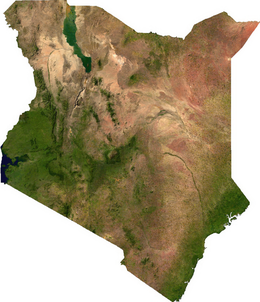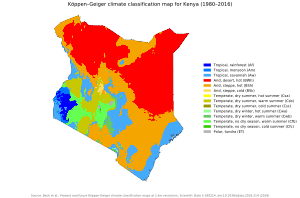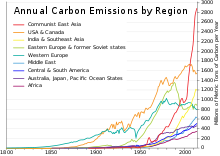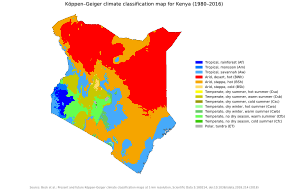Geography of Kenya
 | |
| Continent | Africa |
|---|---|
| Region | East Africa |
| Coordinates | 1°00′N 38°00′E / 1.000°N 38.000°E |
| Area | Ranked 48th |
| • Total | 580,367 km2 (224,081 sq mi) |
| • Land | 98.07% |
| • Water | 1.93% |
| Coastline | 490 km (300 mi) |
| Borders | 3,446 km (2,141 mi) |
| Highest point | Mount Kenya 5,197 metres (17,051 ft) |
| Lowest point | Indian Ocean 0 metres (0 ft) |
| Longest river | Tana River (Kenya) (wholly within Kenya) 800 km (500 mi) |
| Largest lake | Lake Turkana 6,405 km2 (2,473 sq mi) |
| Exclusive economic zone | 116,942 km2 (45,152 sq mi) |


The Geography of Kenya is diverse, varying amongst its 47 counties. Kenya has a coastline on the Indian Ocean, which contains swamps of East African mangroves. Inland are broad plains and numerous hills. Kenya borders South Sudan to the northwest, Uganda to the west, Somalia to the east, Tanzania to the south, and Ethiopia to the north. Kenya currently faces border disputes with South Sudan over the Ilemi Triangle and with Somalia over Jubbaland where, if the Somalian Government gives it up, it could be a new part of Kenya, which would bring the total land area of Kenya to approximately 692,939 km2.
Central and Western Kenya is characterized by the Kenyan Rift Valley and central Province home to the highest mountain, Mount Kenya and Mount Elgon on the border between Kenya and Uganda. The Kakamega Forest in western Kenya is a relic of an East African rainforest. Much bigger is Mau Forest, the largest forest complex in East Africa.
Geography
Location
- Eastern Africa on the Indian Ocean coast between Somalia and Tanzania
- Geographic coordinates: {{coord|1|00|N|38|00|E|type: – hidden this quote as details relate to Karachi, Pakistan not Kenya -->
Area
- Total: 582,650.2 km2 (224,962.5 sq mi)
- Land: 569,140 km2 (219,750 sq mi)
- Water: 11,227 km2 (4,335 sq mi)
- Area comparative
-
- Australia comparative: approximately 5/7 the size of New South Wales
- Canada comparative: slightly smaller than Saskatchewan
- United Kingdom comparative: approximately 21/2 times the size of the United Kingdom
- United States comparative: approximately twice the size of Arizona
- EU comparative: slightly less than twice the size of Italy
Land boundaries
- Total: 3,457 km (2,148 mi)
- Border countries: Ethiopia 867 km (539 mi), Somalia 684 km (425 mi), South Sudan 317 km (197 mi), Tanzania 775 km (482 mi), Uganda 814 km (506 mi)[1]
Coastline
- 490 km (300 mi) along the Indian Ocean.
Maritime claims
- Territorial sea: 12 nmi (22.2 km; 13.8 mi)
- Exclusive economic zone: 116,942 km2 (45,152 sq mi) and 200 nmi (370.4 km; 230.2 mi)
- Continental shelf: 200 m depth or to the depth of exploitation
Geology
Much of the western two-thirds of the country consists of the Pliocene–Pleistocene volcanics deposited on Precambrian basement rocks.[2] The southeast corner of the country is underlain by sediments of the Karoo System of Permian to Late Triassic age and a strip of Jurassic age sediments along the coast in the Mombasa area.[2] The Anza trough is a NW–SE trending Jurassic rift extending from the Indian Ocean coast to the Sudan northwest of Lake Turkana. The Anza Rift resulted from the break–up of Gondwana.[2][3]
Climate

The climate of Kenya varies by location, from mostly cool every day, to always warm/hot by mid afternoon.[4][5][6] The climate along the coast is tropical. This means rainfall and temperatures are higher than inland throughout the year. At the coastal cities, Mombasa, Lamu and Malindi, the air temperature changes from cool to hot, almost every day. (See chart below).[6]
The further inland one is in Kenya, the more arid the climate becomes. An extremely arid climate is nearly devoid of rainfall, and temperature varies widely according to the general time of the day/night. For many areas of Kenya, the daytime temperature rises about 12 °C (corresponding to a rise of about 22 °F), almost every day.[4][5][6]

Elevation is the major factor in temperature levels, with the higher areas, on average, about 11 °C (20 °F) cooler, day or night.[4][5][6] The many cities over a kilometre in elevation have temperature swings from roughly 10–26 °C (50–79 °F). Nairobi, at 1,798 m (5,899 ft), ranges from 9–27 °C (49–80 °F),[4] and Kitale, at 1,825 m (5,988 ft), ranges from 11–28 °C (51–82 °F).[5] At night, heavy clothes or blankets are needed, in the highlands, when the temperature drops to about 10–12 °C (50–54 °F) every night.
At lower altitudes, the increased temperature is like day and night, literally: like starting the morning at the highland daytime high, and then adding the heat of the day, again. Hence, the overnight low temperatures near sea level are nearly the same as the high temperatures of the elevated Kenyan highlands. However, locations along the Indian Ocean have more moderate temperatures, as a few degrees cooler in the daytime, such as at Mombasa (see chart below).
There are slight seasonal variations in temperature, of 4 °C or 7.2 °F,[4][5][6] cooler in the winter months. Although Kenya is centred at the equator, it shares the seasons of the Southern Hemisphere: with the warmest summer months in December–March and the coolest winter months in June–August, again with differences in temperature varying by location within the country.[4][5][6]
On the high mountains, such as Mount Kenya, Mount Elgon and Kilimanjaro, the weather can become bitterly cold for most of the year. Some snowfall occurs on the highest mountains.
| Climate data for Mombasa (at Indian Ocean)[6] | |||||||||||||||
|---|---|---|---|---|---|---|---|---|---|---|---|---|---|---|---|
| NOAA Code | Statistic | Jan | Feb | Mar | Apr | May | Jun | Jul | Aug | Sep | Oct | Nov | Dec | Avg | |
| 0101 | Temperature Average F |
81.7 | 82.6 | 82.9 | 81.7 | 79.2 | 76.6 | 75.2 | 75.2 | 76.5 | 78.3 | 80.4 | 81.3 | 79.3 | |
| 0201 | Temperature High value F |
91.8 | 92.7 | 92.7 | 90.5 | 87.6 | 84.9 | 83.7 | 83.8 | 85.5 | 86.9 | 88.9 | 91 | 88.3 | |
| 0301 | Temperature Low value F |
71.6 | 72.5 | 73.2 | 72.9 | 70.9 | 68.2 | 66.7 | 66.7 | 67.5 | 69.6 | 71.8 | 71.6 | 70.3 | |
| 0615 | Precipitation in inches[6] |
1.4 | 0.6 | 2.3 | 6.3 | 9.7 | 3.6 | 2.9 | 2.8 | 2.8 | 4.2 | 4.3 | 3.1 | 3.7 | |
| 0101 | Temperature Average C |
27.6 | 28.1 | 28.3 | 27.6 | 26.2 | 24.8 | 24.0 | 24.0 | 24.7 | 25.7 | 26.9 | 27.4 | 26.27 | |
| 0201 | Temperature High value C |
33.2 | 33.7 | 33.7 | 32.5 | 30.9 | 29.4 | 28.7 | 28.8 | 29.7 | 30.5 | 31.6 | 32.8 | 31.29 | |
| 0301 | Temperature Low value C |
22.0 | 22.5 | 22.9 | 22.7 | 21.6 | 20.1 | 19.3 | 19.3 | 19.7 | 20.9 | 22.1 | 22.0 | 21.26 | |
| 0615 | Precipitation in mm[6] |
33.9 | 14.0 | 55.6 | 154.3 | 246 | 88.3 | 71.8 | 68.2 | 67.2 | 103.4 | 104.7 | 75.8 | 89.39 | |
| 1109 | Humidity Maximum % |
76.0 | 76.0 | 78.0 | 82.0 | 85.0 | 84.0 | 86.0 | 85.0 | 82.0 | 81.0 | 80.0 | 78.0 | 81.08 | |
| 1110 | Humidity[6] Minimum % |
62.0 | 59.0 | 61.0 | 66.0 | 70.0 | 67.0 | 67.0 | 66.0 | 65.0 | 66.0 | 68.0 | 65.0 | 65.17 | |
Climate change
Climate change is posing an increasing threat to global socioeconomic development and environmental sustainability.[10] Developing countries with low adaptive capacity and high vulnerability to the phenomenon are disproportionately affected. Climate change in Kenya is increasingly impacting the lives of Kenya's citizens and the environment.[10] Climate change has led to more frequent extreme weather events like droughts which last longer than usual, irregular and unpredictable rainfall, flooding and increasing temperatures.
The effects of these climatic changes have made already existing challenges with water security, food security and economic growth even more difficult. Harvests and agricultural production which account for about 33%[11] of total Gross Domestic Product (GDP)[12] are also at risk. The increased temperatures, rainfall variability in arid and semi-arid areas, and strong winds associated with tropical cyclones have combined to create favourable conditions for the breeding and migration of pests.[13] An increase in temperature of up to 2.5 °C by 2050 is predicted to increase the frequency of extreme events such as floods and droughts.[10]
Hot and dry conditions in Arid and Semi-Arid Lands (ASALs) make droughts or flooding brought on by extreme weather changes even more dangerous. Coastal communities are already experiencing sea level rise and associated challenges such as saltwater intrusion.[10] Lake Victoria, Lake Turkana and other lakes have significantly increased in size between 2010 and 2020[14] flooding lakeside communities.[15] All these factors impact at-risk populations like marginalized communities, women and the youth.[12]

Terrain

Kenya's terrain is composed of low plains that rise into central highlands that are, in turn, bisected by the Great Rift Valley. There is also a fertile plateau in the west of the country.
Elevation extremes
The lowest point on Kenya is at sea level on the Indian Ocean. The highest point on Kenya is 5,199 meters above sea level at Mount Kenya.
Rivers
The notable rivers in Kenya are the Athi-Galana-Sabaki River, which at a total length of about 390 kilometers while draining an area of about 70,000 square kilometers, is the second longest river in the country, the Tana River, the longest river in the country at a total length of just over 1000 kilometers, covering a catchment area of over 100,000 square kilometers, and the Nzoia River, which is a 257-kilometre-long (160 mi) river, rising from Mount Elgon, which flows south.
Natural resources
Natural resources that are found in Kenya include: limestone, soda ash, salt, gemstones, fluorite, zinc, diatomite, oil, titanium, gas, gold, gypsum, wildlife and hydropower.
Land use
9.8% of the land is arable; permanent crops occupy 0.9% of the land, permanent pasture occupies 37.4% of the land; forest occupies 6.1% of the land. Other uses make up the rest of Kenya's land. This is as of 2011.
1,032 km2 of Kenyan land was irrigated in 2003.
Total renewable water resources
30.7 km3 (2011)
Freshwater withdrawal
- Total: 2.74 km3/yr (17%/4%/79%)
- Per capita: 72.96 m3/yr (2003)
Gallery
- Thompson (4955 m), Batian (5199 m) and Nelion (5188 m) on Mt Kenya
- The Great Rift Valley as it is visible near Eldoret, Kenya
- The Fourteen Falls near Thika
Natural hazards
Natural hazards include recurring drought and flooding during the rainy seasons.
There is limited volcanic activity in the country. Barrier Volcano (elev. 1,032 m) last erupted in 1921. Several others have been historically active (see List of volcanoes in Kenya).
Environmental issues
Current issues
Current issues that threaten the environment at the moment include water pollution from urban and industrial wastes; degradation of water quality from the increased use of pesticides and fertilisers; deforestation; water hyacinth infestation in Lake Victoria; soil erosion; desertification; and poaching.
International agreements
- Party to: Biodiversity, Climate Change, Climate Change-Kyoto Protocol, Desertification, Endangered Species, Hazardous Wastes, Law of the Sea, Marine Dumping, Marine Life Conservation, Ozone Layer Protection, Ship Pollution (MARPOL 73/78), Wetlands, Whaling.
Extreme points
This is a list of the extreme points of Kenya, the points that are further north, south, east or west than any other location.
- Northernmost point – Kalukwakerith Mountain, Turkana County
- Easternmost point – the tripoint with Ethiopia and Somalia, Mandera County
- Southernmost point – the point where the border with Tanzania enters the Indian Ocean, Kwale County
- Westernmost point – unnamed land west of Port Victoria, Busia County
- Note: Kalukwakerith Mountain is in the disputed Ilemi Triangle region. If this area is excluded then Kenya does not have a northernmost point, the northern border being a straight line.
See also
References
- ^ cia.gov – The World Factbook Kenya
- ^ a b c Petroleum Potential of NW-Kenya Rift Basins: A Synopsis of Evidence and Issues
- ^ L C Greene; D R Richards; R A Johnson (1991). "Crustal structure and tectonic evolution of the Anza rift, northern Kenya". Tectonophysics. 197 (2–4): 203–211. doi:10.1016/0040-1951(91)90041-P. Retrieved 20 November 2011.
- ^ a b c d e f "NairobiDagoretti, Kenya: Climate, Global Warming, and Daylight Charts and Data", Climate-Charts.com, 2008, web: CC741 Archived 29 July 2013 at the Wayback Machine: compare Nairobi/Dagoretti data with or Mombasa charts.
- ^ a b c d e f "Kitale, Kenya: Climate, Global Warming, and Daylight Charts and Data", Climate-Charts.com, 2008, web: CC661 Archived 29 July 2013 at the Wayback Machine.
- ^ a b c d e f g h i j "Mombasa, Kenya: Climate, Global Warming, and Daylight Charts and Data", Climate-Charts.com, 2008, web: CC820 Archived 1 November 2014 at the Wayback Machine: May precipitation was reset as "246" mm, converting 9.7 in.
- ^ Hausfather, Zeke; Peters, Glen (29 January 2020). "Emissions – the 'business as usual' story is misleading". Nature. 577 (7792): 618–20. Bibcode:2020Natur.577..618H. doi:10.1038/d41586-020-00177-3. PMID 31996825.
- ^ Schuur, Edward A.G.; Abbott, Benjamin W.; Commane, Roisin; Ernakovich, Jessica; Euskirchen, Eugenie; Hugelius, Gustaf; Grosse, Guido; Jones, Miriam; Koven, Charlie; Leshyk, Victor; Lawrence, David; Loranty, Michael M.; Mauritz, Marguerite; Olefeldt, David; Natali, Susan; Rodenhizer, Heidi; Salmon, Verity; Schädel, Christina; Strauss, Jens; Treat, Claire; Turetsky, Merritt (2022). "Permafrost and Climate Change: Carbon Cycle Feedbacks From the Warming Arctic". Annual Review of Environment and Resources. 47: 343–371. doi:10.1146/annurev-environ-012220-011847.
Medium-range estimates of Arctic carbon emissions could result from moderate climate emission mitigation policies that keep global warming below 3°C (e.g., RCP4.5). This global warming level most closely matches country emissions reduction pledges made for the Paris Climate Agreement...
- ^ Phiddian, Ellen (5 April 2022). "Explainer: IPCC Scenarios". Cosmos. Archived from the original on 20 September 2023. Retrieved 30 September 2023.
"The IPCC doesn't make projections about which of these scenarios is more likely, but other researchers and modellers can. The Australian Academy of Science, for instance, released a report last year stating that our current emissions trajectory had us headed for a 3°C warmer world, roughly in line with the middle scenario. Climate Action Tracker predicts 2.5 to 2.9°C of warming based on current policies and action, with pledges and government agreements taking this to 2.1°C.
- ^ a b c d "Climate Change Profile: Kenya – Kenya". ReliefWeb. Retrieved 24 November 2020.
- ^ "Agricultural Sector Transformation and Growth Strategy" (PDF). Ministry of Agriculture Livestock and Fisheries. 2019. p. 20. Archived from the original (PDF) on 10 December 2020. Retrieved 8 December 2020.
- ^ a b Climate Change in Kenya focus on Children (PDF) (Report). UNICEF.
- ^ Salih, Abubakr A. M.; Baraibar, Marta; Mwangi, Kenneth Kemucie; Artan, Guleid (July 2020). "Climate change and locust outbreak in East Africa". Nature Climate Change. 10 (7): 584–585. Bibcode:2020NatCC..10..584S. doi:10.1038/s41558-020-0835-8. ISSN 1758-678X. S2CID 220290864.
- ^ Tobiko, Keriako (2021). "Rising Water Levels in Kenya's Rift Valley Lakes, Turkwel Gorge Dam and Lake Victoria" (PDF). Kenya Government and UNDP. Archived from the original (PDF) on 9 October 2022. Retrieved 16 March 2022.
- ^ Baraka, Carey (17 March 2022). "A drowning world: Kenya's quiet slide underwater". the Guardian. Retrieved 17 March 2022.







